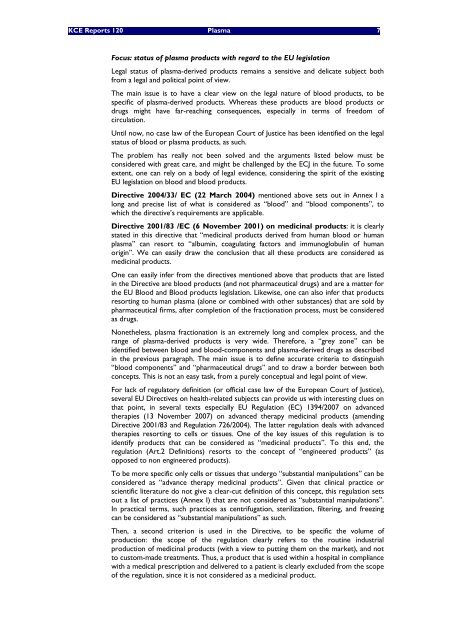The report is available in English with a French summary - KCE
The report is available in English with a French summary - KCE
The report is available in English with a French summary - KCE
You also want an ePaper? Increase the reach of your titles
YUMPU automatically turns print PDFs into web optimized ePapers that Google loves.
<strong>KCE</strong> Reports 120 Plasma 7<br />
Focus: status of plasma products <strong>with</strong> regard to the EU leg<strong>is</strong>lation<br />
Legal status of plasma-derived products rema<strong>in</strong>s a sensitive and delicate subject both<br />
from a legal and political po<strong>in</strong>t of view.<br />
<strong>The</strong> ma<strong>in</strong> <strong>is</strong>sue <strong>is</strong> to have a clear view on the legal nature of blood products, to be<br />
specific of plasma-derived products. Whereas these products are blood products or<br />
drugs might have far-reach<strong>in</strong>g consequences, especially <strong>in</strong> terms of freedom of<br />
circulation.<br />
Until now, no case law of the European Court of Justice has been identified on the legal<br />
status of blood or plasma products, as such.<br />
<strong>The</strong> problem has really not been solved and the arguments l<strong>is</strong>ted below must be<br />
considered <strong>with</strong> great care, and might be challenged by the ECJ <strong>in</strong> the future. To some<br />
extent, one can rely on a body of legal evidence, consider<strong>in</strong>g the spirit of the ex<strong>is</strong>t<strong>in</strong>g<br />
EU leg<strong>is</strong>lation on blood and blood products.<br />
Directive 2004/33/ EC (22 March 2004) mentioned above sets out <strong>in</strong> Annex I a<br />
long and prec<strong>is</strong>e l<strong>is</strong>t of what <strong>is</strong> considered as “blood” and “blood components”, to<br />
which the directive’s requirements are applicable.<br />
Directive 2001/83 /EC (6 November 2001) on medic<strong>in</strong>al products: it <strong>is</strong> clearly<br />
stated <strong>in</strong> th<strong>is</strong> directive that “medic<strong>in</strong>al products derived from human blood or human<br />
plasma” can resort to “album<strong>in</strong>, coagulat<strong>in</strong>g factors and immunoglobul<strong>in</strong> of human<br />
orig<strong>in</strong>”. We can easily draw the conclusion that all these products are considered as<br />
medic<strong>in</strong>al products.<br />
One can easily <strong>in</strong>fer from the directives mentioned above that products that are l<strong>is</strong>ted<br />
<strong>in</strong> the Directive are blood products (and not pharmaceutical drugs) and are a matter for<br />
the EU Blood and Blood products leg<strong>is</strong>lation. Likew<strong>is</strong>e, one can also <strong>in</strong>fer that products<br />
resort<strong>in</strong>g to human plasma (alone or comb<strong>in</strong>ed <strong>with</strong> other substances) that are sold by<br />
pharmaceutical firms, after completion of the fractionation process, must be considered<br />
as drugs.<br />
Nonetheless, plasma fractionation <strong>is</strong> an extremely long and complex process, and the<br />
range of plasma-derived products <strong>is</strong> very wide. <strong>The</strong>refore, a “grey zone” can be<br />
identified between blood and blood-components and plasma-derived drugs as described<br />
<strong>in</strong> the previous paragraph. <strong>The</strong> ma<strong>in</strong> <strong>is</strong>sue <strong>is</strong> to def<strong>in</strong>e accurate criteria to d<strong>is</strong>t<strong>in</strong>gu<strong>is</strong>h<br />
“blood components” and “pharmaceutical drugs” and to draw a border between both<br />
concepts. Th<strong>is</strong> <strong>is</strong> not an easy task, from a purely conceptual and legal po<strong>in</strong>t of view.<br />
For lack of regulatory def<strong>in</strong>ition (or official case law of the European Court of Justice),<br />
several EU Directives on health-related subjects can provide us <strong>with</strong> <strong>in</strong>terest<strong>in</strong>g clues on<br />
that po<strong>in</strong>t, <strong>in</strong> several texts especially EU Regulation (EC) 1394/2007 on advanced<br />
therapies (13 November 2007) on advanced therapy medic<strong>in</strong>al products (amend<strong>in</strong>g<br />
Directive 2001/83 and Regulation 726/2004). <strong>The</strong> latter regulation deals <strong>with</strong> advanced<br />
therapies resort<strong>in</strong>g to cells or t<strong>is</strong>sues. One of the key <strong>is</strong>sues of th<strong>is</strong> regulation <strong>is</strong> to<br />
identify products that can be considered as “medic<strong>in</strong>al products”. To th<strong>is</strong> end, the<br />
regulation (Art.2 Def<strong>in</strong>itions) resorts to the concept of “eng<strong>in</strong>eered products” (as<br />
opposed to non eng<strong>in</strong>eered products).<br />
To be more specific only cells or t<strong>is</strong>sues that undergo “substantial manipulations” can be<br />
considered as “advance therapy medic<strong>in</strong>al products”. Given that cl<strong>in</strong>ical practice or<br />
scientific literature do not give a clear-cut def<strong>in</strong>ition of th<strong>is</strong> concept, th<strong>is</strong> regulation sets<br />
out a l<strong>is</strong>t of practices (Annex I) that are not considered as “substantial manipulations”.<br />
In practical terms, such practices as centrifugation, sterilization, filter<strong>in</strong>g, and freez<strong>in</strong>g<br />
can be considered as “substantial manipulations” as such.<br />
<strong>The</strong>n, a second criterion <strong>is</strong> used <strong>in</strong> the Directive, to be specific the volume of<br />
production: the scope of the regulation clearly refers to the rout<strong>in</strong>e <strong>in</strong>dustrial<br />
production of medic<strong>in</strong>al products (<strong>with</strong> a view to putt<strong>in</strong>g them on the market), and not<br />
to custom-made treatments. Thus, a product that <strong>is</strong> used <strong>with</strong><strong>in</strong> a hospital <strong>in</strong> compliance<br />
<strong>with</strong> a medical prescription and delivered to a patient <strong>is</strong> clearly excluded from the scope<br />
of the regulation, s<strong>in</strong>ce it <strong>is</strong> not considered as a medic<strong>in</strong>al product.

















